The Best Board Games We Played at PAX Unplugged 2022
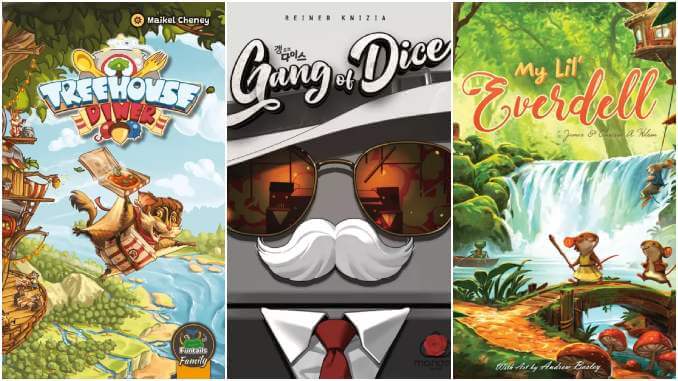
PAX Unplugged, the PAX empire’s annual tabletop convention in Philadelphia, was back in full swing this year, with three more days of open gaming, tournaments, new releases, and more. As always, I was there for the entire event, and spent most of my time in the convention’s invaluable First Look area, where players can try out new and upcoming titles, many of which are appearing in the U.S. for the first time. Here’s a rundown of everything I played:
Evergreen
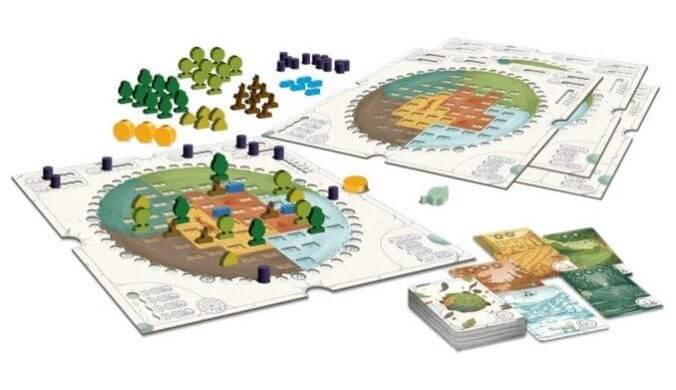
I saw this game demoed at Gen Con but finally got to play it at PAX Unplugged, and I’m glad I did. It’s by the same designer as the game Photosynthesis, and it’s a clear sequel to that game, borrowing several of the same mechanics but streamlining those rules and using smaller, easier to handle components. As in the earlier game, players are planting trees and gaining points for the sunlight that hits them as the sun token moves around the board, although here everyone has their own player board rather than everyone playing on the same board. Your board has different terrains that function in two ways: You draw a card showing a terrain in which you plant sprouts or grow them into trees, while cards no one selects move down into the ‘fertility’ area that determines what the trees in each terrain are worth at the end of the game. Photosynthesis looked better on the table, but I think Evergreen is the better experience.
The Wandering Towers (Die wandelnden Türme)
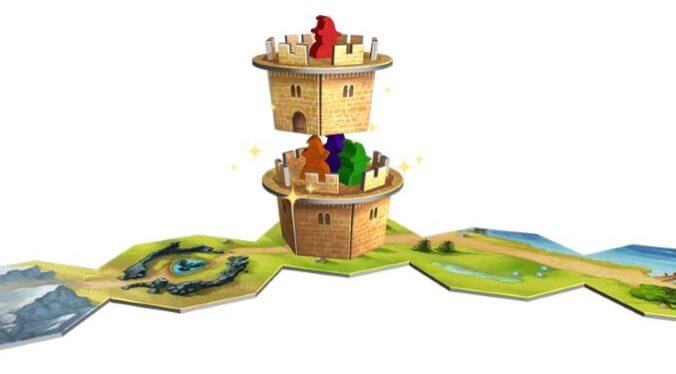
The super successful tandem of designers Michael Kiesling and Wolfgang Kramer, who designed Torres and Tikal together and who have a bunch of hits as solo artists as well, are behind this fun family game where players try to get their five wizards around the circular board into the raven tower. They can also move the towers around to trap other players’ wizards for a bonus, and to slow their progress. It’s easy to learn and makes the take-that part of the game very fun because of how you move the towers, with a challenge to remember where your trapped wizards actually are. It’s listed for players 8 and up but I don’t see any reason a 6-year-old couldn’t play this.
Take a Seat
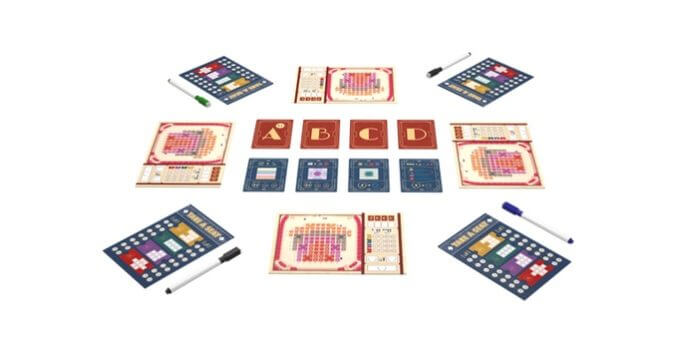
Not a roll-and-write, or a flip-and-write, but there is writing here—although you have control over what you write on each turn, except when the players to your left and right interfere with your plans. Players try to fill in the seats on their own theater boards by coloring in shapes that shrink over the course of the game as players fill in those shapes on separate boards they pass back and forth between turns—you fill in one circle on your turn, then your neighbor fills in one on the next turn, and you have to use the shape after they’ve messed with it. There are objective cards in each game that give you more points bonuses as well.
Terra Nova (Capstone)

I’m not a big fan of Terra Mystica, which puts me out of step with fans of complex games, as it’s been ranked in the top 25 on Boardgamegeek’s all-time rankings for just about all of the 10 years since its release. Terra Mystica is a heavy game, with a weight of nearly 4 on BGG’s 1-5 scale, with 1 being the lightest game and 5 being… Cones of Dunshire on steroids? (The weights are generated via user votes, and I find them more reliable than the game ratings on BGG.) Not only did I find Mystica too heavy and long, it’s also kind of boring. Terra Nova, on the other hand, is a shorter, simpler variant, re-imagined by first-time designer Andreas Faul, and it is worlds better than the original: shorter (about an hour), easier to learn, and much more fun. The core idea of the game is the same: Each player has a unique species that wants to spread out and populate a map of hexes showing five different terrain types, each of which is the home terrain for a specific species. You can build on hexes showing your species’ preferred terrain, or you can alter other hexes as a separate action to make them suitable for building. If you get four or more adjacent hexes with enough buildings on them, you create a city for immediate and game-end bonuses. You can also rack up points in each round by using a specific action or building type for that round. The worker-placement part of the original is gone, as you just take actions directly on the board, the cult tracks are also gone, and there are three building types instead of five. It’s a better experience that still has the best parts of the original game.
Lacrimosa
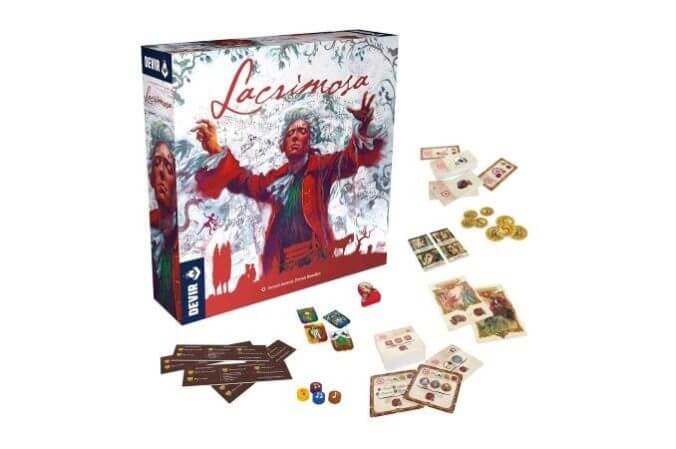
My full review of this medium-heavy game will be up this week; it’s an absolutely gorgeous game based loosely on the story of Mozart’s life and the Requiem he left unfinished at his death. Players represent his patrons, recalling their partnerships with Mozart and also hiring musicians and composers to try to complete the Requiem. The game’s best mechanic is its use of a nine-card deck for each player that determines actions and resources in each round; players cycle through the whole deck in each of the game’s five epochs, and can upgrade the deck by buying cards, removing one from their deck to keep the total at nine. There’s a solid economic game hidden beneath its surface.
My Lil Everdell
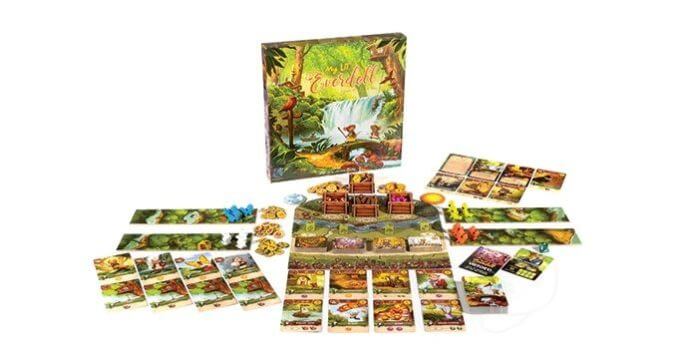
The trend of creating kids’ versions of popular ‘adult’ games continues to produce some gems like Dragomino, Quacks & Co., and now My Lil Everdell, a perfectly stripped-down version of the amazing Everdell, my #1 game of 2018. That game involved worker placement, resource management, tableau building, card drafting, a tech tree, and more in a tight game that could run as little as 40 minutes if the players already knew the game. My Lil Everdell cuts things way down, removing the tech tree and eliminating one resource, making it way easier to collect the resources that are left and simplifying the powers of a lot of the cards. Players get 12 actions over the entire game, using them to get resources and buy cards in five different categories, with easy to understand bonuses for collecting different sets. It’s simple, quick to play, and has the same sort of incredibly cute art as the original.
Applejack
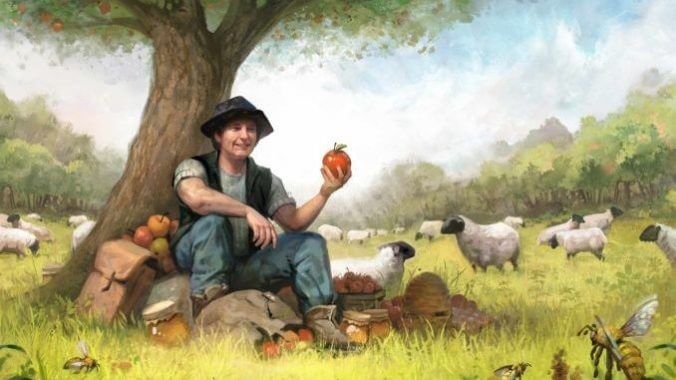
A smaller design from Uwe Rosenberg (Agricola, Patchwork), Applejack has players placing hex tiles on their own boards to gain points from beehives, apples, and flowers on those tiles, each of which scores in a slightly different way. Apples come in various colors and their tiles must be adjacent to score, while flowers can be anywhere and are worth twice as much the second time they score. There’s a lot of addition in the final scoring but the individual moves you make are pretty easy to understand.
Gang of Dice

A Reiner Knizia design featuring a push-your-luck mechanic. On each turn you choose how many dice to roll and then try to get the highest total of any player without violating the restriction on that round’s card, which might say no odd numbers, or no sequences of three consecutive numbers, and so on.
Texas Showdown
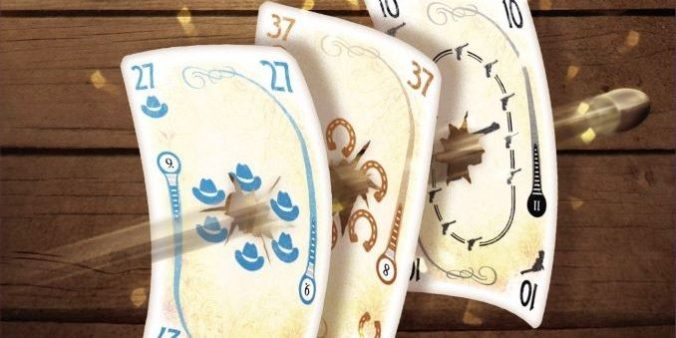
A 2015 game that hasn’t been published in the U.S. yet—although Rio Grande has acquired the rights to do so and will rename it Seas of Strife—Texas Showdown is a trick-taking game where you don’t want to win the tricks. There are multiple suits in the deck, which has values from 0 to 74, and you must follow suit—but if you can’t, you can play any suit, and then subsequent players can follow that suit or the first one, and so on. Any game that gets the table laughing and trash-talking without being stupid is a win for me, so I’m hopeful Rio Grande gets this one out soon.
Coral

A block-placement game where players try to place blocks of their color on top of other players’ blocks to make theirs the most visible when the final structure is viewed from the top down. It’s been published in Europe, but not here, and I do think the rules could use some improved translating.
Beer & Bread
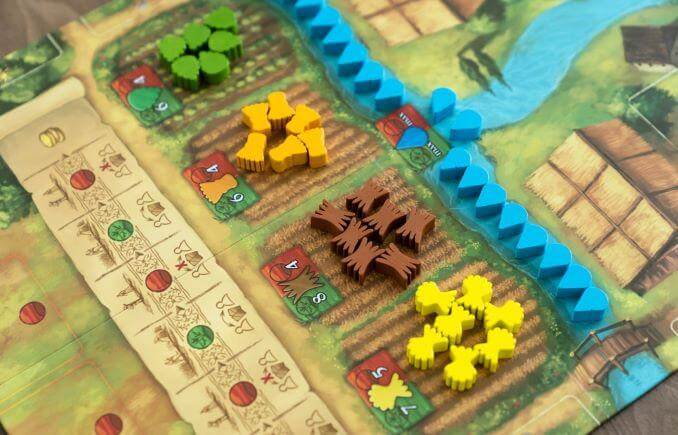
A two-player game from Scott Almes (the Tiny Epic series, Claim) and Capstone Games, Beer & Bread is just what it sounds like—players gather resources to complete cards (like contracts) to bake beer or brew beer. In odd-numbered rounds, the four resources are plentiful, and players trade hands after each turn. In even-numbered rounds, those resources are scarce, players don’t trade hands, and there are three additional cards available on the table for players to exchange for hand cards. Players can use the cards they have for the resources at the top, to complete the recipe in the middle, or for the upgrade shown at the bottom, which might allow the player to store more resources, keep more than one loaf of bread/one batch of beer, or gain additional resources for free at certain points. Capstone was selling it at PAXU—and they sold out—but it’s not at retail yet.
Crossing Oceans

A reimplementation of the 2017 game Transatlantic, Crossing Oceans has one really substantial addition: An actual map, which makes a ton of sense for a game about buying ships to carry cargo around the world. Players buy and place ships on the board, then use them in different ways to take in income so they can buy bigger, better, faster ships. Designer Mac Gerdts has also borrowed the rondel action mechanism from his own game Navegador, where your next action is determined by your movement around a circle that limits you to what’s in the next three spaces unless you pay something to move farther. It’s a midweight economic game, but plays better on the map, although I wish the trading post action was more powerful relative to other options.
Treehouse Diner

Rüdiger Dorn, designer of Istanbul and Alhambra, redid a 2015 game of his called Da Luigi as Treehouse Diner, giving it a cute theme that fits the light game play. Players get cards showing orders for customers at their diners, which they must fill with specific sets of two to four ingredients, but to take ingredients, they must move those orders down one spot per ingredient on their own boards to represent the time taken to prep those orders—and if you run out of time on an order, it falls off the board and you lose a point on your Mood track. It’s light enough for kids, but there’s some tension here in the way orders move down your board, especially since you’re forced to take another order any time another player chooses to take orders as their action, giving the game a little more weight but maybe making it harder for younger players.
Sauscharf

Another Wolfgang Kramer game, Sauscharf is a super-light set collection game with a novel mechanic for gaining new cards. In phase one, each player plays a set of matching cards from their hands to the table, and the strongest set gets to select all cards of one number from the row on the table. In the second phase, that still applies, but this time, you can either use your set to get new cards, or you can play it to claim an objective card that requires anywhere from two to nine matching cards to complete it. I found it a little too simple for my tastes, and the way you have to keep burning your cards just to gain one new one to add to a set made the game longer than it needed to be.
I also met with numerous publishers at the convention, so here’s a rundown of what I gathered from those conversations.
Wizkids had a demo of the upcoming game Rebuilding Seattle, which is not, as it turns out, about the Big One that’s going to dump Seattle into the Pacific in the next quarter-century or so, but about rebuilding the city after the Great Fire of 1899. Players lay tiles on their own neighborhood boards, expanding as they go and gaining points for icons they cover (a bit like Bärenpark), with all kinds of public and private objectives that change game to game. It’s due out in January. Featherlight is out now, and it is, indeed, a light card game that plays like a simpler Fantasy Realms—you want to get the most valuable five-card hand by game-end, based on the point bonuses shown on those cards, which refer to cards in your hand and/or the six cards in the ‘nest’ on the table.
Lucky Duck has several titles coming out in the next few months. Oros is a mid-weight tile placement game of world-building and track advancement, where players will lay tiles on the world board, or move them into each other to push up mountains or volcanoes, taking rewards to move up the eight (!) different tracks on their own player boards. Some of those make future actions more powerful, while others increase game-end bonuses. It’s now available for pre-order. My Shelfie is an upcoming Phil Walker-Harding game you can play now on Board Game Arena, where you place one to three tiles at a time into your Connect Four-like ‘bookshelf’ to match various patterns on public and private objective cards. Nimalia is a small-box game of pattern-matching as well, as players lay cards showing 2×2 patterns of animals and terrains on each other (as in Honshu) and score differently in each round but scoring each metric multiple times during the five-round game (as in Cartographers). The latter two games will be out in the first quarter of 2023.
Hachette: Miller Zoo is a cooperative legacy game based on an actual zoo in Québec, aimed at family play (ages 8+) with each session running about a half an hour thanks to simultaneous play. It’s due out in the summer. In the Footsteps of Darwin is an upcoming light game based on the voyage of the great scientist with a rondel tile selection mechanism as players follow the path of the Beagle on its voyages. Skyteam is a cooperative two-player game where players play as the pilot and co-pilot of a plane and must work together to land it, rolling dice behind their own screens (as in the co-op game Fuji) and only talking before they roll their dice. It’s due out in Q3. Gosu X is a rethemed version of a 2012 game called Gosu 2, mashing up Riftforce and Magic: the Gathering in a two-player game where players each have decks made of cards from three unique factions, while the two unchosen factions end up altering the rules of the game. Vivarium and Vaalbara are both beautiful small-box games built around set collection mechanics. I couldn’t get near Tribes of the Wind, a meatier game (30 minutes per player) with 7 Wonders-like interaction and art reminiscent of the films of Hayao Miyazaki, in the First Look section because it was so popular. And Rauha is an upcoming game from the designers of Nidavellir, this time a card-drafting game where players place Biome cards on their personal 3×3 boards to try to create matching rows/columns and build sets of actions for subsequent turns. All of the last four games are due in May-ish.
Flatout’s next big release, Fit to Print, fully funded almost immediately on Kickstarter, which ends on Dec. 9. Those of you who worked on your school newspapers may enjoy the game’s core mechanic: you’re laying out your newspaper with articles and ads, trying to adhere to certain rules to increase points and income, and it involves a real-time element like Galaxy Trucker’s where players rush to grab the right tiles from a central pile. (There will be turn-based rules as well, for those of you too soft to make it in this ink-stained wretch’s world.) Their latest release Verdant—a new game from the designers of Calico and Cascadia, closer in weight to the latter of those games—was on sale. Players draft cards from the central row in a mechanic almost identical to Cascadia’s, and then place them in their 3×5 tableau, alternating plant cards and room cards, trying to match them up to get the right sunlight on plants and match patterns for bonuses. I’ve played this once already and it’s a clear winner.
Distant Rabbit is a new publisher whose first game, Mantis Falls, actually came out right around PAX Unplugged 2021. This 2-3 player game of hidden identities has been a hit with its semi-cooperative mechanic: You’re all working together, unless one of you is a spy, and then it’s you against them. You can’t reveal your role at any point, so it’s a game of trust, and maybe betrayal, as you try to escape the town of the game’s name—or to kill your colleague(s) instead.
Pandasaurus’s biggest new release, The Wolves, is an area-control game where players try to build out their pack of wolves to have the most power in each region and move up six tracks on their player boards. Orichalcum is co-designed by Bruno Cathala (Kingdomino, Five Tribes, Jamaica), and brings the 4X style into an hour-long game, with players vying to collect unobtanium orichalcum for more victory points. The Kickstarter for The Fox Experiment, co-designed by Wingspan designer Elizabeth Hargrave, was a huge success, of course, and the game is set for a release next summer.
KOSMOS had several new Exit: the Game titles, including a Lord of the Rings-themed one, although their very popular Exit Advent calendar games have sold out. Karak was first released in 2017 but is coming back with a new printing, as the very popular entry-level game brings a dungeon crawl to younger players (ages 7+, per the box). Two to five players move through a modular board they fill as they go, drawing and flipping tiles that might show monsters to battle or treasures to gain. It’s a competitive game, though, not a cooperative one like most games of its ilk.
I didn’t get to demo Restoration Games’s latest announced title, a reboot of the 1980s smash-em-up game Crossbows and Catapults, but as someone who owned the original game, I’m irrationally excited for it. Restoration also had Return to Dark Tower, which had a second successful Kickstarter run and was also available for purchase in their booth; and Key to the Kingdom, a reboot of a 1990 game that retains the original’s modular board but makes it far less luck-based.
Keith Law is the author of The Inside Game and Smart Baseball and a senior baseball writer for The Athletic. You can find his personal blog the dish, covering games, literature, and more, at meadowparty.com/blog.